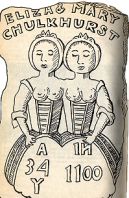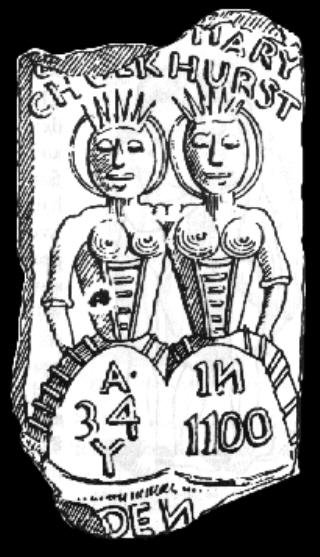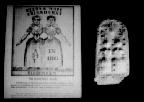 DESIGNS & COLORS | INGREDIENTS | FLAVORS | PRICES & PAYMENT | COMMENTS | CONTACT | LINKS INFORMATION ON HARTSHORN | A BRIEF HISTORY OF SPRINGERLE | OUR 16th c. MERCHANT BOOTH MOLDED COOKIES IN HISTORY | PHOTO GALLERY MOLDED COOKIES IN HISTORY The Unique &
Fascinating Story of The Biddenden Maids
From Anomalies and Curiosities of Medicine
by George M Gould and Walter L Pyle.
http://www.zoraskingdom.freeserve.co.uk/4class1.htm <Dec. 5, 2004> The " Biddenden Maids " were born in Biddenden, Kent, in 1100. 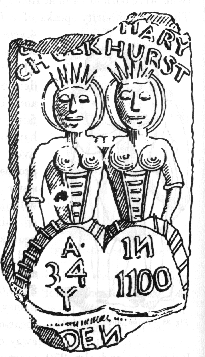 Their names were Mary and Eliza
Chulkhurst, and their parents were fairly well-to do people. They were
supposed to have been united at the hips and the shoulders, and lived
until 1134. At the death of one it was proposed to separate them, but
the remaining sister refused, saying, "As we came together, we will
also go together," and, after about six hours of this Mezentian
existence, they died. They bequeathed to the church-wardens of the
parish and their successors land to the extent of 20 acres, at the
present time bringing a rental of about $155.00 annually, with the
instructions that the money was to be spent in the distribution of
cakes (bearing the impression of their images, to be given away on each
Easter Sunday to all strangers in Biddenden) and also 270 quartern
loaves, with cheese in proportion, to all the poor in said parish.
Ballantyne has accompanied his description of these sisters by
illustrations, one of which shows the cake (right). Heaton gives a very
good description of these maids; and a writer in "Notes and Queries"
of March 27, 1876, gives the following information relative to the
bequest:
"On Easter Monday, at Biddenden,
near Staplehurst, Kent, there is a distribution, according to ancient
custom, of 'Biddenden Maids' cakes,' with bread and cheese, the cost of
which is defrayed from the proceeds of some 20 acres of land, now
yielding £35 per annum, and known as the 'Bread and Cheese
Lands.' About the year 1100 there lived Eliza and Mary Chulkhurst, who
were joined together after the manner of the Siamese twins, and who
lived for thirty-four years, one dying, and then being followed by her
sister within six hours. They left by their will the lands above
alluded to, and their memory is perpetuated by imprinting on the cakes
their effigies 'in their habit as they lived.' The cakes, which are
simple flour and water, are four inches long by two inches wide, and
are much sought after as curiosities. These, which are given away, are
distributed at the discretion of the church-wardens, and are nearly 300
in number. The bread and cheese amounts to 540 quartern loaves and 470
pounds of cheese. The distribution is made on land belonging to the
charity, known as the Old Poorhouse. Formerly it used to take place in
the Church, immediately after the service in the afternoon, but in
consequence of the unseemly disturbance which used to ensue the
practice was discontinued.
The Church used to be filled with
a congregation whose conduct was occasionally so reprehensible that
sometimes the church-wardens had to use their wands for other purposes
than symbols of office. The impressions of the 'maids' on the cakes are
of a primitive character, and are made by boxwood dies cut in 1814.
They bear the date 1100, when Eliza and Mary Chulkhurst are supposed to
have been born, and also their age at death, thirty-four years."
The Biddenden Maids, Mary and
Eliza Chulkhurst, were probably the best-known conjoined twins before
Chang and Eng. The girls were born in 1100 to a wealthy family in the
village of Biddenden, Kent, England. They were joined at the hip and
were likely pygopagus twins; illustrations show them also joined at the
shoulder, although no documented set of conjoined twins has ever shared
multiple points of juncture. This illusion was probably created when
the sisters walked with their arms wound around each other's shoulders.
When the girls died in 1134, they left their entire fortune to the
church. Until the early 1900s, a festival held in Biddenden
commemorated the generous gift of the twins, and "Biddenden cakes",
which were made in plaster molds bearing an image of the Chulkhurst
sisters, were given to the poor. Today, a collection of cottages known
as the Chulkhurst estate stands on the 20 acres donated to the church
by the sisters. When one sister died, the other refused to be separated
(probably a wise decision, given the medical technology of the 12th
century) and died six hours later. The Chulkhurst sisters are discussed
at length in Bondeson's The
Two-Headed Boy.
From A Social History of Conjoined Twins
http://zygote.swarthmore.edu/cleave4b.html
<Dec. 5, 2004> One of the earliest documented
cases of conjoined twins are Mary and Eliza Chulkhurst, also known as
the Biddenden Maids. Born in 1100, the sisters lived for 34 years in
Biddenden, County of Kent, England. Mary and Eliza, though often
depicted as joined at the hip and shoulders, were likely pygopagus
twins who were joined at the buttocks and lower backs. After the death
of one sister, doctors hoped to save the life of the other by
separating them surgically. The surviving twin refused, declaring, "As
we came together, we will go together." She died several hours later.
Upon their deaths, a local church received 20 acres of land. In
remembrance of their generosity, small cakes and biscuits imprinted
with the image of the sisters were given to the poor every Easter
Sunday. Nearly 900 years after their deaths, the Biddenden Maids are
still honored by this unique service.
Biddenden Maid card and "cake."
Mütter Museum, Philadelphia.
Queen Elizabeth's Gingerbread 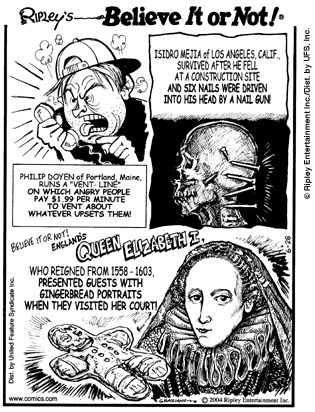 HOW TO PLACE AN ORDER (Please contact us before placing any order.) Pay by
PayPal! Click the "Buy Now" Link:
We accept:
For more information, additional prices, etc., contact us at:
|
Goode Cookys & Gode Cookery are © 1997-2007 James L. Matterer
